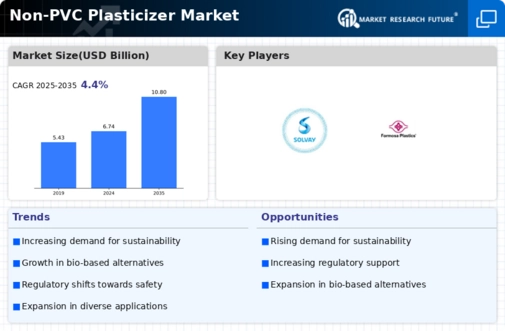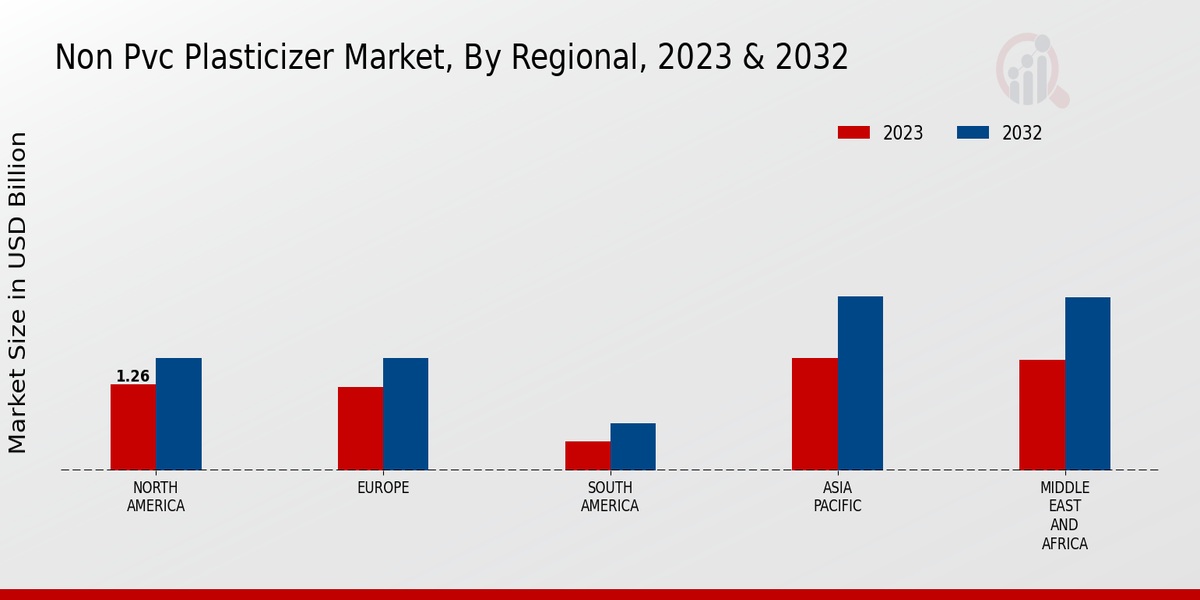Market Growth Projections
The Global Non-PVC Plasticizer Market Industry is anticipated to experience robust growth, with projections indicating a market value of 6.74 USD Billion in 2024 and a potential increase to 10.8 USD Billion by 2035. This growth trajectory suggests a compound annual growth rate (CAGR) of 4.42% from 2025 to 2035. Such figures reflect the increasing adoption of non-PVC plasticizers across various sectors, driven by consumer demand for safer and more sustainable materials. The market's expansion is likely to be influenced by ongoing innovations and regulatory changes that favor non-toxic alternatives, positioning the industry for a promising future.
Consumer Awareness and Health Concerns
Heightened consumer awareness regarding health risks associated with traditional plasticizers significantly impacts the Global Non-PVC Plasticizer Market Industry. As consumers become more informed about the potential dangers of phthalates and other harmful chemicals, there is a marked shift towards safer alternatives. This trend is particularly evident in the food packaging and children's products sectors, where safety is paramount. Manufacturers are responding by developing non-PVC plasticizers that meet consumer expectations for health and safety. This growing demand for safer products is likely to contribute to the market's expansion, as consumers increasingly prioritize health-conscious choices.
Growing Demand for Eco-Friendly Products
The increasing consumer preference for environmentally friendly products significantly drives the Global Non-PVC Plasticizer Market Industry. As awareness of the harmful effects of traditional PVC plasticizers rises, manufacturers are shifting towards non-toxic alternatives. This trend is evident in various sectors, including construction and automotive, where sustainable materials are prioritized. The market is projected to reach 6.74 USD Billion in 2024, reflecting a robust demand for eco-conscious solutions. Companies are investing in research and development to innovate and produce bio-based plasticizers, further enhancing their market position and appealing to environmentally aware consumers.
Rising Applications in Various Industries
The versatility of non-PVC plasticizers across multiple industries fuels growth in the Global Non-PVC Plasticizer Market Industry. Applications span from construction materials to consumer goods, where flexibility and durability are paramount. For example, the automotive industry increasingly utilizes non-PVC plasticizers in interior components to enhance performance and reduce weight. This broad applicability ensures a steady demand, with projections indicating the market could reach 10.8 USD Billion by 2035. As industries continue to recognize the benefits of non-PVC alternatives, the market is poised for sustained expansion, driven by diverse application needs.
Regulatory Support for Non-Toxic Alternatives
Government regulations promoting the use of non-toxic plasticizers bolster the Global Non-PVC Plasticizer Market Industry. Various countries are implementing stringent regulations to limit the use of harmful substances in consumer products, thereby encouraging manufacturers to adopt safer alternatives. For instance, the European Union's REACH regulation has led to increased scrutiny of chemical substances, pushing industries to seek compliant solutions. This regulatory landscape not only enhances consumer safety but also opens avenues for growth in the non-PVC segment. As a result, the market is expected to grow at a CAGR of 4.42% from 2025 to 2035, indicating a sustained shift towards safer materials.
Technological Advancements in Production Processes
Innovations in production technologies are propelling the Global Non-PVC Plasticizer Market Industry forward. Advanced manufacturing techniques, such as the development of bio-based plasticizers and improved synthesis methods, enhance product performance and reduce costs. These advancements allow manufacturers to produce high-quality plasticizers that meet diverse application needs across various industries, including packaging and textiles. The market's growth trajectory is supported by these technological improvements, which not only increase efficiency but also align with sustainability goals. As the industry evolves, these innovations are likely to play a crucial role in expanding the market's reach and capabilities.













